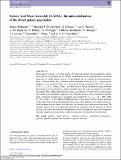Files in this item
Galaxy And Mass Assembly (GAMA) : the unimodal nature of the dwarf galaxy population
Item metadata
| dc.contributor.author | Mahajan, Smriti | |
| dc.contributor.author | Drinkwater, Michael J. | |
| dc.contributor.author | Driver, S. | |
| dc.contributor.author | Kelvin, Lee S. | |
| dc.contributor.author | Hopkins, A. M. | |
| dc.contributor.author | Baldry, I. | |
| dc.contributor.author | Phillipps, S. | |
| dc.contributor.author | Bland-Hawthorn, J. | |
| dc.contributor.author | Brough, S. | |
| dc.contributor.author | Loveday, J. | |
| dc.contributor.author | Penny, Samantha J. | |
| dc.contributor.author | Robotham, A. S. G. | |
| dc.date.accessioned | 2018-01-23T11:30:22Z | |
| dc.date.available | 2018-01-23T11:30:22Z | |
| dc.date.issued | 2015-01-21 | |
| dc.identifier | 252100226 | |
| dc.identifier | 002e05fb-4af6-4a8b-9cf6-62e6cb4d7864 | |
| dc.identifier | 84985914473 | |
| dc.identifier | 000350272300061 | |
| dc.identifier.citation | Mahajan , S , Drinkwater , M J , Driver , S , Kelvin , L S , Hopkins , A M , Baldry , I , Phillipps , S , Bland-Hawthorn , J , Brough , S , Loveday , J , Penny , S J & Robotham , A S G 2015 , ' Galaxy And Mass Assembly (GAMA) : the unimodal nature of the dwarf galaxy population ' , Monthly Notices of the Royal Astronomical Society , vol. 446 , no. 3 , pp. 2967-2984 . https://doi.org/10.1093/mnras/stu2009 | en |
| dc.identifier.issn | 0035-8711 | |
| dc.identifier.other | ArXiv: http://arxiv.org/abs/1409.7295v1 | |
| dc.identifier.uri | https://hdl.handle.net/10023/12583 | |
| dc.description.abstract | In this paper we aim to (i) test the number of statistically distinct classes required to classify the local galaxy population and (ii) identify the differences in the physical and star formation properties of visually distinct galaxies. To accomplish this, we analyse the structural parameters – effective radius (Reff), effective surface brightness within Reff (⟨μ⟩e), central surface brightness (μ0) and Sérsic index (n) – obtained by fitting the light profile of 432 galaxies (0.002 < z ≤ 0.02; VikingZ band), and their spectral energy distribution using multiband photometry in 18 broad-bands to obtain the stellar mass (M*), the star formation rate (SFR), the specific SFR (sSFR) and the dust mass (Mdust), respectively. We show that visually distinct, star-forming dwarf galaxies (irregulars, blue spheroids and low-surface-brightness galaxies) form a unimodal population in a parameter space mapped by ⟨μ⟩e, μ0, n, Reff, SFR, sSFR, M*, Mdust and (g − i). The SFR and sSFR distribution of passively evolving (dwarf) ellipticals on the other hand, statistically distinguish them from other galaxies with similar luminosity, while the giant galaxies clearly segregate into star-forming spirals and passive lenticulars. We therefore suggest that the morphology classification scheme(s) used in literature for dwarf galaxies only reflect the observational differences based on luminosity and surface brightness among the apparent distinct classes, rather than any physical differences between them. | |
| dc.format.extent | 1824791 | |
| dc.language.iso | eng | |
| dc.relation.ispartof | Monthly Notices of the Royal Astronomical Society | en |
| dc.subject | Galaxies: dwarf | en |
| dc.subject | Galaxies: evolution | en |
| dc.subject | Galaxies: fundamental parameters | en |
| dc.subject | Galaxies: general | en |
| dc.subject | Galaxies: star formation | en |
| dc.subject | Galaxies: structure | en |
| dc.subject | QB Astronomy | en |
| dc.subject | QC Physics | en |
| dc.subject | 3rd-DAS | en |
| dc.subject.lcc | QB | en |
| dc.subject.lcc | QC | en |
| dc.title | Galaxy And Mass Assembly (GAMA) : the unimodal nature of the dwarf galaxy population | en |
| dc.type | Journal article | en |
| dc.contributor.institution | University of St Andrews. School of Physics and Astronomy | en |
| dc.identifier.doi | 10.1093/mnras/stu2009 | |
| dc.description.status | Peer reviewed | en |
This item appears in the following Collection(s)
Items in the St Andrews Research Repository are protected by copyright, with all rights reserved, unless otherwise indicated.

